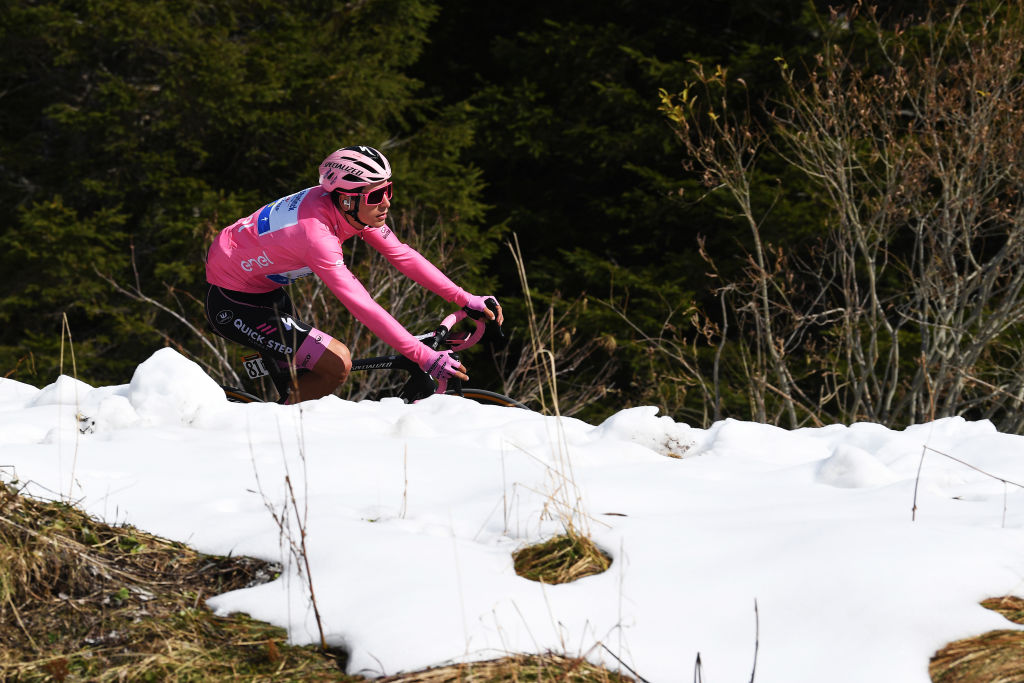Almeida: I know I can be dropped there, but I like the Stelvio
Portuguese rider carries 17-second lead into Giro d’Italia’s hardest stage

When Fausto Masnada pulled up by the barriers past the finish line at Madonna di Campiglio, it was put to him that his Deceuninck-QuickStep team had got the 0-0 draw they were seeking from the first leg of the Giro d’Italia’s closing triptych of mountain stages.
“We’re more than happy,” Masnada said. “We’re ahead in the race so we have to ride to defend ourselves. There’s no sense in attacking. We have to control things and that’s what we did.”
Maglia rosa João Almeida finished safely alongside his overall rivals on stage 17, maintaining his 17-second lead over Wilco Kelderman (Sunweb) and bleeding some more kilometres and mountain passes off the countdown to Milan. His fellow countryman José Mourinho would have found much to admire in the way he managed a slender advantage on the road to Madonna di Campiglio.
Deceuninck-QuickStep controlled affairs at the head of the gruppo for much of the day, which began with the long ascents of Forcella Valbona and Monte Bondone, and though their numbers thinned at the base of the final climb, Masnada was on hand to anchor Almeida’s defence in the closing kilometres, setting the tempo on the approach to the finish.
Almeida himself, meanwhile, marked Kelderman tightly, including when the Dutchman and his Sunweb teammate Jai Hindley (3rd overall at 2:58) launched a short-lived, two-pronged attack with 6km remaining. At one point, Almeida perhaps even channelled Mourinho when he turned to speak to Kelderman as the pink jersey group briefly fanned across the road, though he downplayed the idea that he been indulging in psychological warfare with his closest rival.
“After the attack, the pace was high and the group was small,” Almeida said. “I just told him, ‘Now I don’t have any riders to put a tempo on the climb.’ Fausto made the tempo after that, but I was just trying to say there was a good pace, but I didn’t have any riders.
“Today was hard, but the last climb was not the hardest climb, it was not so steep. My goal was just to keep the jersey, to keep the gap. I was expecting Kelderman to attack and he tried, but I felt good.”
Get The Leadout Newsletter
The latest race content, interviews, features, reviews and expert buying guides, direct to your inbox!
Stelvio
Since taking the maglia rosa on Mount Etna on stage 3, Almeida has repeatedly downplayed the idea that he might carry the jersey all the way to Milan. His chances certainly seemed to diminish when Kelderman slashed his buffer so clinically at Piancavallo on Sunday, but the Portuguese rider received a sudden – though not wholly unexpected – boost to his prospects on Wednesday afternoon, when it was confirmed that stage 20 will no longer cross into France due to the coronavirus pandemic, thus removing the Colle dell'Agnello and the Col d'Izoard from the route in one fell swoop.
The stage will instead tackle three rather shallower ascents of Sestriere, a challenge that seems altogether more amenable to Almeida’s characteristics. Race director Mauro Vegni was even moved to anoint the Portuguese youngster as the favourite for overall victory. “Sestriere will be hard but what we’ve seen from this boy, it will be hard to pull the time back from him there,” Vegni said admiringly.
Before then, however, Almeida faces into the toughest stage of this Giro and, indeed, of any Grand Tour this season. The fearsome Stelvio is the centrepiece of the tappone on Thursday, but the road to the summit finish at Laghi di Cancano also takes in the Campo Carlo Magno and the Passo Castrin, which features for the first time in the Giro.
The terrain is favourable to attackers, and not just the Sunweb duo of Kelderman and Hindley. Riders like Tao Geoghegan Hart (4th at 2:59), Vincenzo Nibali (7th at 3:31) and Jakob Fuglsang (12th at 5:09) know that this is, effectively, their last chance to put themselves in a position to win the race. “The strategy will be to try to control the best riders,” Deceuninck-QuickStep directeur sportif Davide Bramati told RAI,
Both Bramati and Almeida know, of course, there are limits to strategy on a day such as this. The temperature atop the Stelvio will be in single digits, and the freezing descent will discommode riders still further ahead of the stiff final climb to Laghi di Cancano. Ultimately, Almeida will either be strong enough to resist the inevitable onslaught or he will not. Such is the terrible beauty of the third week of the Giro.
“I actually like the climb. I know I can be dropped there, but I like the climb,” Almeida said of the Stelvio. “I think it’s a great climb. In the end, I just hope that the strongest rider wins.”

Barry Ryan was Head of Features at Cyclingnews. He has covered professional cycling since 2010, reporting from the Tour de France, Giro d’Italia and events from Argentina to Japan. His writing has appeared in The Independent, Procycling and Cycling Plus. He is the author of The Ascent: Sean Kelly, Stephen Roche and the Rise of Irish Cycling’s Golden Generation, published by Gill Books.